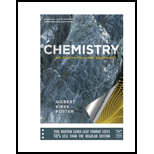
To find:
a) The percent difference in the carbon-14 decay rate in biological samples from 1360 BCE and 1628 BCE.
b) The ratio of carbon-14: carbon-12 in the blackened grains compared with that of the grain harvested last year.
Answer to Problem 21.82QA
Solution:
a) The percent difference in the carbon-14 decay rate in biological samples from 1360 BCE and 1628 BCE = 3%
b) The ratio of carbon-14: carbon-12 in the blackened grains from the Jericho site (1315
Explanation of Solution
1) Concept:
From the half-life of nuclear decay, and the ratio of isotopes, we can calculate the isotopic ratios backwards in time. This is a powerful tool for radioactive dating techniques. This technique is used extensively for geological dating of various fossils, and rocks.
Ratio of C-14 to C-12 is a powerful tool used for radioactive dating..
2) Formula:
i)
ii)
where,
3) Given:
i)
ii)
4) Calculations:
The half-life of
So, the rate constant is calculated as follows:
Part a)
Calculation using
Calculation using
Therefore, the percent difference is
Thus the percent difference in the carbon-14 decay rate in biological samples from 1360 BCE and 1628 BCE = 3%
Part b)
So,
Calculation using
Calculation using
Therefore, the percent difference is
For grain harvested last year, take t = 1 year.
k =
Thus the ratio of carbon-14: carbon-12 in the blackened grains from the Jericho site (1315
Conclusion:
The ratio of carbon-14: carbon-12 is calculated using the first order radioactive decay equation.
Want to see more full solutions like this?
Chapter 21 Solutions
Chemistry: An Atoms-Focused Approach
 ChemistryChemistryISBN:9781305957404Author:Steven S. Zumdahl, Susan A. Zumdahl, Donald J. DeCostePublisher:Cengage Learning
ChemistryChemistryISBN:9781305957404Author:Steven S. Zumdahl, Susan A. Zumdahl, Donald J. DeCostePublisher:Cengage Learning ChemistryChemistryISBN:9781259911156Author:Raymond Chang Dr., Jason Overby ProfessorPublisher:McGraw-Hill Education
ChemistryChemistryISBN:9781259911156Author:Raymond Chang Dr., Jason Overby ProfessorPublisher:McGraw-Hill Education Principles of Instrumental AnalysisChemistryISBN:9781305577213Author:Douglas A. Skoog, F. James Holler, Stanley R. CrouchPublisher:Cengage Learning
Principles of Instrumental AnalysisChemistryISBN:9781305577213Author:Douglas A. Skoog, F. James Holler, Stanley R. CrouchPublisher:Cengage Learning Organic ChemistryChemistryISBN:9780078021558Author:Janice Gorzynski Smith Dr.Publisher:McGraw-Hill Education
Organic ChemistryChemistryISBN:9780078021558Author:Janice Gorzynski Smith Dr.Publisher:McGraw-Hill Education Chemistry: Principles and ReactionsChemistryISBN:9781305079373Author:William L. Masterton, Cecile N. HurleyPublisher:Cengage Learning
Chemistry: Principles and ReactionsChemistryISBN:9781305079373Author:William L. Masterton, Cecile N. HurleyPublisher:Cengage Learning Elementary Principles of Chemical Processes, Bind...ChemistryISBN:9781118431221Author:Richard M. Felder, Ronald W. Rousseau, Lisa G. BullardPublisher:WILEY
Elementary Principles of Chemical Processes, Bind...ChemistryISBN:9781118431221Author:Richard M. Felder, Ronald W. Rousseau, Lisa G. BullardPublisher:WILEY





